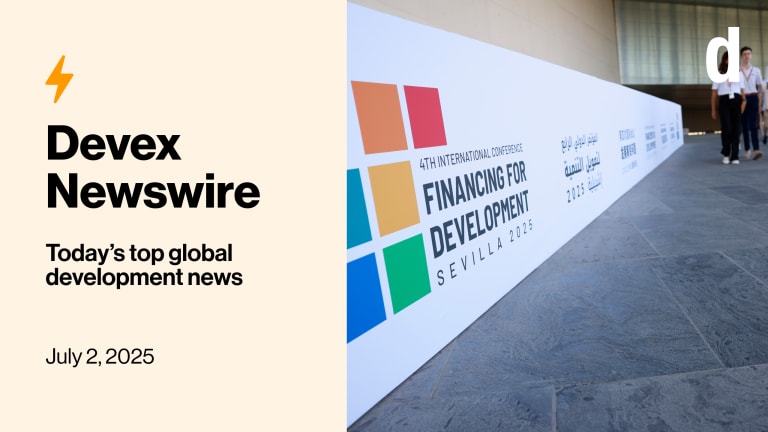
EDITOR’S NOTE: The World Bank published last week its latest country classification by income, which influences how both multilateral and bilateral aid is allocated. Martin Ravallion, non-resident fellow at the Center for Global Development, analyzes the changes in the ranking and how they can affect future development policy.
You may have seen the small flurry of media attention given last week to the World Bank’s July 1 posting of its latest country classification by income. These are used extensively by the bank in both its operations and its data products, such as the hugely popular World Development Indicators, as well as by many others outside the bank. They influence aid allocations (both multilateral and bilateral).
The main news from last week’s posting is that a number of extra countries have joined the bank’s category of high-income countries or HICs. The seemingly lucky countries are Antigua and Barbuda, Chile, Lithuania, Latvia, Russia and Uruguay. (In other changes, Iraq, Belize, and Fiji moved up to upper-middle income status. Hungary got demoted from HIC to the upper-middle group. South Sudan fell from lower-middle to low. The complete country listing can be found here.)
This was seen as good news to many in the promoted countries. With regard to Russia, the Moscow Times reported that the ranking shows that Russia “has nearly caught up with the majority of developed countries.” There is some risk of exaggeration here, as Russia’s GNI per capita was $12,700 in 2012, so it just barely made it into the HIC group. The significance of having some Latin American countries join the ranks of HICs for the first time did not go unnoticed in the development community. For example, in a July 4 press conference in Santiago, World Bank chief Jim Yong Kim acclaimed Chile’s ”great achievement” in reaching HIC status.
The sustained economic growth in these newly declared HICs may well be cause for celebration, though not everyone will be celebrating I am sure. But we should pause to ask: What exactly does the bank’s declared HIC status mean? It turns out that this question is surprisingly hard to answer.
The World Bank’s post for its new income classifications tells us that the minimum income required today for the bank to label a country high-income is a GNI of $12,616 per capita. For some unknown reason — possibly institutional inertia — the currency conversion does not use purchasing power parity exchange rates, which would appear to be better suited to this task than the moving average of official exchange rates that is currently used in the bank’s outdated “Atlas method.”
But my question here is: Where does this $12,616 cut-off come from? The site announcing the new classifications points us to a ”Short History.” I had high hopes when I saw this link, but I was soon disappointed—there is not much “history” and it is a bit too “short.” We are told that the income cut-off point for being called a HIC was set in 1989 at a GNI of $6,000 per person per year in 1987 prices. And the $6,000 has been updated over time for what is called “international inflation,” which turns out to be the average inflation rates of Japan, the United Kingdom, the United States, and the Euro Zone. To rationalize the original thresholds we are told this:
“The process of setting per capita income thresholds started with finding a stable relationship between a summary measure of well-being such as poverty incidence and infant mortality on the one hand and economic variables including per capita GNI estimated based on the bank’s Atlas method on the other. Based on such a relationship and the annual availability of bank’s resources, the original per capita income thresholds were established. Thereafter, the original thresholds have been updated every year to incorporate the effect of international inflation, which is now measured by the average inflation of Japan, the United Kingdom, the United States and the Euro Zone. Thus, the thresholds remain constant in real terms over time.”
There is no documentation on the site about this “stable relationship” — either about the relationship back in the 1980s or how it has changed over time. It is also unclear what “stable relationship” means here. And readers may wonder why the bank’s resources (in the 1980s) are relevant to defining whether a country is a LIC, MIC, or HIC, either in the 1980s or now. There are some methodological notes, but they throw no further light on the mysterious income classifications. There are not even references to source documents. A broader web search did not leave me any wiser. The trail is dead and the mystery remains.
We are told just a little more in the “short history” about the origin of the cutoff used for going from low- to middle- income country (LIC to MIC). The graduation threshold for going from LIC to MIC was set in 1988 at the value of the Bank’s “Civil Works Preference,” which had been set at a GNI of $200 per capita in 1971. CWP in 1971! It would not be unfair to say that this is an “arcane threshold” as Charles Kenny has put it. The threshold has only been updated over time for inflation. Naturally, with a fixed real threshold, many countries have graduated from LIC to MIC, but it is unclear what significance can be attached to that fact. By standard measures those countries still account for the majority of the world’s poor (as Andy Sumner and others have pointed out, and I also discuss here.)
And why should the cut-offs have constant real value over time? We can quibble about the set of countries chosen for measuring “international inflation.” But even if we put that issue aside, without a clearer understanding of what it means to be considered a high-income country or a low-income country we cannot say how the thresholds should be adjusted over time, let alone what it means at any one date.
The World Bank is free to set arbitrary thresholds for its lending operations, although it is not clear that this is desirable or necessary in practice. (I discuss this issue further here.) In future, the bank might try to define its income classifications relative to agreed social goals, including poverty reduction and human development. One might search in current data for that mysterious “stable relationship” in the quote above. Or one might look for categorizations that make sense in terms of external assistance needs. Measurement is difficult but not impossible. (For example, elsewhere I have proposed a measure of domestic capacity for fighting poverty without external assistance.) Maybe it will be decided that there is no option but to make some entirely arbitrary cut-off. Fine, but then please tell everyone that this is the case. Users of these data deserve to know.
The bank has done great work in recent years in making its global data bases more open to public scrutiny. But openness is not just about putting data on websites. It is also about the clarity, rigor, and transparency of the concepts used. Greater openness about the rationale, or lack of it, for prominent features of these data, such as the World Bank’s influential country classifications by income, would be welcome.
Edited for style and republished with permission from the Center for Global Development. Read the original article.




